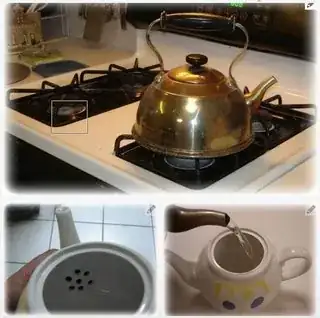Basic electric tea kettles primarily work by turning off when a bimetallic switch in the handle (probably at the bottom, where it will require some steam pressure to have steam travel down to) of the kettle is sufficiently heated to deform one of the metals, turning off the kettle. This switch is heated by steam, and the element itself is typically turned off well below 100°C (closer to 85°, perhaps) to ensure it doesn't go on heating indefinitely, particularly well above sea level. This ensures it is boiling, as the steam pressure required to move the steam to heat the element doesn't exist until the water is at a full boil.
As such, you can't assume any specific temperature from the kettle without knowing your altitude, and most accurately taking the temperature yourself. It does not heat to a specific temperature independent of altitude/pressure and stop, if you're using one of the cheaper models; if you have a model that has digital temperature control, then of course you can simply set that.
Now, the temperature it stops at is quite stable, for your altitude; so if you determine that temperature (either with an accurate thermometer, or by searching the internet and/or doing the math to find out what temperature water boils at where you live) it's likely very consistent. So if you are looking for 96°C, and where you live water boils at 98°C, you can work out how to drop it those two degrees pretty easily.
Example information:
UK Museum of Science and Industry article about Kettles
John Taylor, one of the early inventors of this kind of switch
Russell Hobbs, another UK company that pioneered this process, and includes some information as to how it works on the page:
The automatic electric kettle K1 (a world first), designed in October 1955, used a bi-metallic strip at the rear of the kettle: steam was forced through an aperture in the lid of the strip and this knocked the switch, turning the kettle off.[3]
(I can't source that actual statement, as [3] doesn't go to a page that uses this language, but it's within reason compared to other similar pages.)
